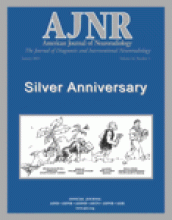Carotidynia is an unilateral neck pain syndrome associated with tenderness to palpitation over the carotid bifurcation, first described by Fay in 1927 (1). We performed ultrasonographic (US) investigation in six consecutive cases that fulfilled clinical criteria of idiopathic carotidynia according to the former International Headache Society classification (2). In all patients, hypoechoic wall thickening of the carotid bulb was found exactly in the region of tenderness, leading to a mild lumen narrowing and a large outward extension of the vessel wall. In some cases, the wall thickening was found in two different layers of the vessel wall (Fig 1A). Follow-up US 3–5 weeks later showed significantly fewer pathologic findings (Fig 1B). In two patients, MR imaging of the carotid bifurcation showed no evidence of intramural hematoma. The findings correspond to recently published MR imaging data that described abnormally enhancing tissue surrounding the symptomatic carotid artery in five cases of carotidynia (3); in one of these patients, MR imaging was repeated after resolution of symptoms and showed normal findings (3). In a recently published case of carotidynia, histologic findings of inflammation of the carotid adventitia were presented (4); however, the cause of the inflammatory process remained obscure.
Our findings of a similar US pattern in six patients suggest that idiopathic carotidynia is a distinct entity, possibly caused by inflammation.
US findings in a case of carotidynia. CCA, common carotid artery. ICA, internal carotid artery.
A, Initial findings of wall thickening, leading to a mild lumen narrowing and a major outward extension of the vessel.
B, Follow-up findings 4 weeks later show significantly fewer pathologic findings.
- Copyright © American Society of Neuroradiology













